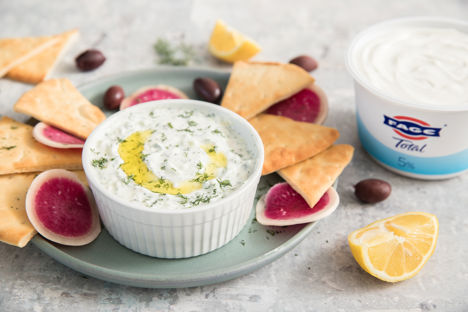
FAGE: bringing strained yoghurt to the world
It’s a common ingredient in the UK today, but strained yoghurt was very hard to come by in Britain until FAGE brought it over in the 1980s. We take a look at what makes its yoghurt stand out from the rest, how the business grew from humble beginnings nearly 100 years ago and why it’s such a useful ingredient in cooking.
FAGE: bringing strained yoghurt to the world
It’s a common ingredient in the UK today, but strained yoghurt was very hard to come by in Britain until FAGE brought it over in the 1980s. We take a look at what makes its yoghurt stand out from the rest, how the business grew from humble beginnings nearly 100 years ago and why it’s such a useful ingredient in cooking.
There’s a reason so many recipes call for strained yoghurt. It’s creamier and thicker than the plain variety. It’s lower in sugar with a pleasingly tart flavour. It’s nutritious and – most importantly of all – tastes delicious. Hard to believe that before the 1980s, it was all but non-existent in UK shops. That was, until, a Greek dairy company called FAGE (pronounced fah-yeh) started exporting it into the country from Athens.
FAGE has been making and selling yoghurt since 1926, when Athanassios Filippou’s family opened a dairy shop in central Athens. Above all, it was the family’s yoghurt that proved popular, boasting a rich, creamy texture and indulgent taste. But why is FAGE’s yoghurt so good?
For yoghurt to become Greek yoghurt, it needs to be strained. The yoghurt itself is made like any other, but unlike thinner, more watery plain yoghurts, Greek yoghurt is strained of its whey until thick, luscious and rich in protein. The resulting product is perfect for dipping, dolloping, marinating or creating sauces with, retaining its thicker, stiffer texture and absorbing other flavours beautifully.
FAGE’s recipe takes this process further, requiring four litres of milk to produce just one litre of its yoghurt, before being mixed with the company’s own live active yoghurt cultures. This is what gives the yoghurt its distinctive flavour and sets it apart from other strained yoghurts. It’s then slow-fermented, allowing the cultures to work their magic, before going through a unique straining process to remove the watery whey and create FAGE’s signature Total yoghurt. It is this unique process which creates the yoghurt FAGE’s customers love. Deliciously thick and creamy and high in protein.
Today, FAGE sets the standard for top-quality strained yoghurt across the world. By the 1950s it had established itself as Greece’s top yoghurt producer, and when the business decided to start exporting its products to the UK and Italy in the 1980s, it introduced the rest of the world to a brand new ingredient; something as indulgent and luscious as cream but with the lactic tang of natural yoghurt. The company, while now international is still family-owned to this day, ensuring the same time, care and attention is put into every pot. It’s one of the best examples of true strained yoghurt you can buy – perfect for cooking with or simply dolloping onto sweet and savoury dishes. The original recipe contains five percent fat, but it’s also made into two percent and zero percent fat yoghurts, providing even more options for people looking to eat well without sacrificing flavour.
How to use strained yoghurt in cooking
The flavour and texture of FAGE Total yoghurt makes it a joy to cook with. It’s the obvious choice for making dips and dressings with, particularly those from the Mediterranean and Middle East (where strained yoghurt is the norm). It adds a rich creaminess when stirred through sauces and works wonders when marinating meat, as the acidity in the yoghurt promotes tenderness. Strained yoghurt is also a fantastic carrier of flavour, so something as simple as stirring herbs, spices and aromatics into it will produce a top-class dip, dressing, sauce or marinade.
Of course, yoghurt is just at home in sweet dishes as it is in a savoury context. You can bake with it; use it in place of cream cheese for a lighter, more flavourful cheesecake; churn it into frozen yoghurt or simply dollop it on top of fresh fruit. As ingredients go, there aren’t many that are as versatile as yoghurt – and FAGE Total yoghurt is the best you can get.

